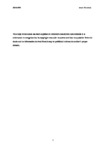Philip Guston’s Absurd and the Sisyphean Affirmation in the Battle for Existentialism
| dc.contributor.supervisor | Bokody, Peter | |
| dc.contributor.author | Blacklock, Jason | |
| dc.contributor.other | Faculty of Arts, Humanities and Business | en_US |
| dc.date.accessioned | 2021-02-04T16:01:59Z | |
| dc.date.available | 2021-02-04T16:01:59Z | |
| dc.date.issued | 2021 | |
| dc.identifier | 10545398 | en_US |
| dc.identifier.uri | http://hdl.handle.net/10026.1/16849 | |
| dc.description.abstract |
Abstract Philip Guston’s Absurd and the Sisyphean Affirmation of the Battle for Existentialism – By Jason Blacklock This dissertation offers an Existentialist interpretation of the life and work of Philip Guston. Discourse regarding avant-garde New York School artists and their knowledge and manipulation of Existentialism has an illustrious rollcall. Dore Ashton and Harold Rosenberg, amongst others have added their powers of exegesis to contemporary work by Mark Rothko, Jackson Pollock, and Willem de Kooning. Amongst this canon of America’s great twentieth century Abstract-Expressionists Philip Guston’s work is often noted, but rarely aligned fully with Existentialist and particularly Absurdist values. I propose that Absurdism can be linked to Guston’s work in three ways. First, by reviewing his biography I suggests that he was exposed to fundamental traumas early on. Second, close visual analysis of his paintings will be used here to identify Absurdist concerns. In these sections I am adopting the Absurdist terminology in order to describe and interpret his visual output. Third, I will make also some tentative links between the paintings and his actual knowledge of philosophy. This will be underpinned by Guston’s readings and associations throughout his social and political life. His involvement with Muralism and the WPA during the Great Depression, and connection to Modern Man discourse following the Second World War. This covers Guston’s entanglement with Primitive and Aesthetic forces, in the Nietzschean sense as a guiding factor in Guston works; these forces are particularly manifest in Guston’s New York School and abstract period and culminate in his return to figurative works. The divergence between the two theories posited by Albert Camus and Jean-Paul Sartre, and their interpretation by New York School artists is key. Camus’ liberal cultural leftism i.e. rebellion in the face of a stony-faced establishment, and Sartre direct action in communication with society at large pushing for Marxist revolution, will be shown to converge in Guston’s later figurative works. This dissertation seeks through three chapters to quantify Guston’s position as his period’s Sisyphus. Further, it posits that the antithetical sense in which Guston operated was informed by his reading and experiences both from childhood and throughout his adult life. Guston’s empiric experience and understanding of Existentialist doctrine will be examined. His reading of a multitude of literary texts from Franz Kafka to Pasternak, Valery, Mallarme, and of course Sartre and Camus as attested by his daughter Musa Mayer will be woven into Guston 10545398 Jason Blacklock 7 narrative. This intermingles with Guston’s detachment and distance from society. And exacerbates his ability as watcher and maintenance of an Absurd distance from a world alienated from the artist. Dore Ashton and Robert Slifkin will be key to interpreting Guston’s development particularly his sense of process and arts position of finding a frozen moment in eternal evolution as expression of multiple struggles. This moment in three separate paradigms expresses the battle riven period of the early to mid-twentieth century as Guston attempts to express substance and find expression amid a world in turmoil. Chapter one will chart the beginnings of a uniquely gifted painter’s personal alienation, from Guston senior’s suicide to the Great Depression. Chapter two will explore Guston’s celebrated AbstractExpressionist phase. And chapter three will circumnavigate Guston’s alienation from an ever more consumer driven marketplace, telling stories rebelling against dogma and writing messages in abstraction. This thesis will reveal Guston’s own bibliography from Gogol to Sartre and from Kafka to Samuel Beckett. Through Guston’s words and with my supporting bibliography a complex web will be weaved using chosen works which reveal an Absurdist rebel seeking painterly absolution. | en_US |
| dc.language.iso | en | |
| dc.publisher | University of Plymouth | |
| dc.rights | Attribution-ShareAlike 3.0 United States | * |
| dc.rights.uri | http://creativecommons.org/licenses/by-sa/3.0/us/ | * |
| dc.subject | Existential | en_US |
| dc.subject | Art History | |
| dc.subject | Absurdist | |
| dc.subject | Social History | |
| dc.subject | Biographical | |
| dc.subject.classification | ResM | en_US |
| dc.title | Philip Guston’s Absurd and the Sisyphean Affirmation in the Battle for Existentialism | en_US |
| dc.type | Thesis | |
| plymouth.version | publishable | en_US |
| dc.identifier.doi | http://dx.doi.org/10.24382/746 | |
| dc.rights.embargoperiod | No embargo | en_US |
| dc.type.qualification | Masters | en_US |
| rioxxterms.version | NA |
Files in this item
This item appears in the following Collection(s)
-
01 Research Theses Main Collection
Research Theses Main



